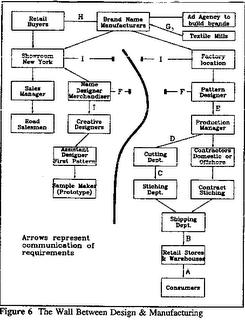
Kathleen at Fashion Incubator had an excellent blog today on the confusion of "what Technical Designers do".
http://www.fashion-incubator.com/mt/ I said that I will only add more confusion, because the "concept of technical design" has become a "buzzword" for so many aspects of the industry, used by those who don't know very much about the technical aspects.
As the organizer for the Boston fashion Industry Meetup, http://fashion.meetup.com/1/ I meet a few members who work as technical designers. Almost all of them work for retail chains in product development departments, who produce lots of design "samenesses" overseas. None of them truly know pattern making, but blindly follow a bunch of "specs" that I have found to be pretty silly to accomplish anything worthwhile. Measurements and CAD will never get beautiful "shape", which a really good pattern maker is able to do.
I have watched the apparel industry change over six decades. In the 1940s & 1950s, pattern makers for manufacturers in the Boston area were called "designers". The word "design" means "making a plan", so the concept of "technical" was assumed. A "pattern", to me, is an information system (IT, today)) for producing one or many same garment styles. Anyone who created were "sketchers", and pretty meaningless. It was the fashion schools in New York in the 50s and 60s that began the tremendous confusion. The teachers were all dressmakers that taught pattern making from their knowledge of home patterns, not production on factory floors. To this day I have yet to see any fashion school teach what I call "production pattern making" or "pattern engineering".
As the manufacturers left the northeast and went south, and then overseas, the great apprenticeship system for learning production pattern making died. And then the schools, with teachers who didn't know it, produced a wave of pattern makers that could only follow rules that were established before them. When I first went to work in New York fashion rooms in the 1950s, I was shocked that none knew anything about production in patterns or stitching. ( I started as a stitcher in factories as a teenager in the 1940s.)
In one of my National Science Foundation grants on engineering design (1988, "Apparel-Textile Codification & Image Communication technology"), I drew a graphic I called the "Wall Between Design and Manufacturing", to show the critical problems, and "fighting conflicts" between the socalled "fashion designers" in the New York showrooms and the production pattern makers at the manufacturers factory. I said I would, and I did, put up this graphic here above.
How do we answer this problem of less and less expert knowledge on pattern making for production, and more and more confusion of terms for DEs, such as "technical design". I don't know. Maybe we need to talk more about the "future"? How can we change the way things are to something better? Kathleen is certainly helping with her book and this blog. Thanks. How about you readers? Have any ideas? Please make some comments, or ask some questions.

3 comments:
Shirley,
This "wall" is very common in the engineering world, as well. Many companies are so focused on the end result that they ignore the process it takes to get there. I've seen so many companies where the "creative" people put together graphic storyboards for web sites or software screen designs, then toss it over the wall to software developers. The problem is that there is a fundamental disconnect between what is desired for an end result and the skill it takes to implement the creative bits.
Too many creative folks don't know how their design will be turned into something real and too many of the implementers don't know how to handle the creative aspects or know what parts can be sacrified and what can't.
I agree that it's the educational system that is too black and white. To them, you're either creative or you're not. They don't seem to get that there is a middle ground. Most of the best engineers I know didn't do so well in engineering "book work", but excelled in the hands-on process, where they could exercise their creative and logical sides at the same time. There needs to be more interdisciplinary exposure instead of simple pigeonholing. It doesn't do much good to design a garment if it can't be made.
Violette,
You left a great comment that the engineering world has similar problems. I would truly like to converse with you more about this, to know more about you and your background for knowing this. But when I clicked on your profile there was nothing there?? Please contact me.
shirley@shirleywillett.com
Violette,
I think your comment about engineers who"excelled in the hands-on process, where they could exercise their creative and logical sides at the same time" suggests something very interesting. The created incompatibility of "left brain" and "right brain" thinking has never made sense to me, since I am good at both. But career tracks all seem to be aimed at one or the other, not both. And yet, your comment suggests that to excel in some of the careers seen as far to one or the other side, one really needs to develop both kinds of thinking. Imagine a Renaissance artist who didn't have the craftsman's technical mastery of pigments, for instance.
Shirley I'm enjoying your thoughts on this blog. I'm just starting myself - don't expect to see a profile yet. I am curious about your suede dress - did the design require that material? Or did the construction method?
Post a Comment